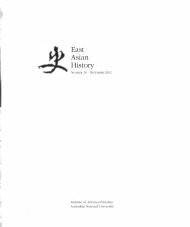Mujaku Dochu (1653-1744) and 17th-Century ... - East Asian History
Mujaku Dochu (1653-1744) and 17th-Century ... - East Asian History
Mujaku Dochu (1653-1744) and 17th-Century ... - East Asian History
Create successful ePaper yourself
Turn your PDF publications into a flip-book with our unique Google optimized e-Paper software.
MUJAKU DOCHU<br />
27<br />
zokyo 1\ B *1.\7tJ1UI) of 1905-12Y <strong>Mujaku</strong>'s 1728 edition of the Record of<br />
Lin-chi CLin-chi lu rg), a key text of the Rinzai yg sect, has become<br />
the st<strong>and</strong>ard text. It was reproduced by Hirano Soja .ljL1f*i1'r in 1971, <strong>and</strong><br />
<strong>Mujaku</strong>'s commentary on this text was the major influence on the translations<br />
of Yanagida Seizan <strong>and</strong> Paul Demieville.12<br />
<strong>Mujaku</strong> left 477 works, some extremely long, on subjects as diverse<br />
as popular beliefs like the koshin $, calendars, chrestomathies of<br />
colloquial Chinese, poetry, monastic gazetteers, text-critical editions, phonology,<br />
common-place books, catalogues, name lists of famous Japanese,<br />
as well as Zen <strong>and</strong> other Buddhist commentaries. Yanagida Seizan has<br />
described his devotion to scholarship as unrivalled in Japan, <strong>and</strong> "possibly<br />
all of Buddhist history",13 <strong>and</strong> Bernard Faure wrote that "<strong>Mujaku</strong><br />
deserves a place of choice in the portrait gallery of the precursors of the<br />
'scientific' historiography of Chan/Zen". 14 In his own lifetime, <strong>Mujaku</strong> was<br />
three times the abbot of Myoshinji yy{,\, then one of the two greatest<br />
Rinzai Zen monastic headquarters, <strong>and</strong> in 1684 he published his Summary<br />
of the Pure Regulations [Adapted] for Small [Zen] Monasteries CShosorin<br />
ryakushingi !J\**IB§$;ID, a set of regulations <strong>and</strong> guides to ritual for<br />
smaller monasteries. The only work he published in his lifetime, it is still<br />
used today <strong>and</strong> has been republished a number of times, including in<br />
the Taisho Tr ipitaka. 15 Moreover, <strong>Mujaku</strong> was the historian of Myoshinji,<br />
not only writing its Gazetteer on the Mountain of the Correct Dharma<br />
CShobozanji .IE?tLiJli:t), which was published in modern print in 1979,<br />
but also gathering together many documents of successive abbots <strong>and</strong><br />
reorganising the monastery's financial documentation.16<br />
<strong>Mujaku</strong> was also well known in his lifetime for his scholarship on<br />
Zen, judging from the number of requests <strong>and</strong> letters he received enquiring<br />
about his opinions on a variety of textual questions. Among his correspondents,<br />
although only once if the record is complete, was Hakuin<br />
Ekaku B ,¥!!l (1642-1741), usually considered the father of modern<br />
Rinzai practiceY <strong>Mujaku</strong> was an elite monk, for not only was he an abbot<br />
of a large <strong>and</strong> famous monastery <strong>and</strong> head of a sub-temple Ctatchii m)<br />
sponsored by the daimyo of Choshu :flHI'1 <strong>and</strong> of Suo mllllJ for 67 years,<br />
his teachers <strong>and</strong> associates were numbered among the most influential<br />
of Zen monks. His teacher, Jikuin Somon EPt'§'F (1610-77) was one<br />
of those responsible for inviting the Obaku Jt monk, Yin-yUan Lungch'i<br />
51Ji (1592-1673) to Myoshinji in the mid-1650s, hoping that he<br />
would be appointed abbot there. This created a split in the Myoshinji community.<br />
Somon founded Ryuge'in IjUl;WfG, <strong>Mujaku</strong>'s sub-temple, originally<br />
to accommodate Lung-ch'i, but a break between Lung-ch'i <strong>and</strong> Somon<br />
occurred around 1657 18 Yet among <strong>Mujaku</strong>'s confidants <strong>and</strong> advisors was<br />
Saiun Data *mf* (1637-1713), who welcomed Lung-ch'i to Japan in<br />
1654 <strong>and</strong> became his lifelong attendant. Some time after Lung-ch'i's death,<br />
Data left Manpukuji W;, Lung-ch'i's monastery, <strong>and</strong> retired to Nara-<br />
11 I have used the reprint, the Hsu-tsang<br />
ching [Continued Tripitaka] 150 vols. (Taipei:<br />
HSin-wen-feng Publishing Company, 1968-70,<br />
hereafter HTC, volume number, page, register<br />
<strong>and</strong> line number); HTC 119.190-202.<br />
12 Hirano Sojo, comp., Teihon Rinzai zenji<br />
goroku [St<strong>and</strong>ard Text of the Recorded Sayings<br />
of Ch'an Teacher Lin-chi] (Tokyo: Shunjusha,<br />
1971), including <strong>Mujaku</strong>'s kunten wliiM see<br />
p.157, <strong>and</strong> <strong>Mujaku</strong>'s post-face, p.88. See<br />
also, Yanagida Seizan, Kunchu Rinzai roku<br />
[Annotated Lin-chi lu] (Kyoto: Kichudo, 1961),<br />
p.7; <strong>and</strong> Paul Demieville, Entretiens de Lin-lSi<br />
[The Sayings of Lin-chi] (Paris: Fayard, 1972),<br />
pp.15--6, who wrote, "He was a Sinologist of<br />
class, who participated in a great philological<br />
movement inaugurated in the Confucian<br />
domain by scholars such as Ito Jinsai (1627-<br />
1705) <strong>and</strong> Ogyu Sorai (1666-1728) ... ".<br />
1 3 Yanagida Seizan, "<strong>Mujaku</strong> <strong>Dochu</strong> no gakumon"<br />
[The Scholarship of <strong>Mujaku</strong> <strong>Dochu</strong>] in<br />
Yanagida Seizan, comp., Chokushu Hyakuja<br />
shingi sakei [Commentarial Keys to the<br />
Imperially Revised Pure Regulations of Paichang],<br />
Zengaku sosho (Kyoto: Chubun<br />
shuppansha, 1977), Vol.2, pp.1335-36.<br />
14 Bernard Faure, Chan Insights <strong>and</strong> Oversights:<br />
An Epistemological Critique of the Chan<br />
Tradition (Princeton: Princeton University<br />
Press, 1993), pp.100-3.<br />
15 No.2579, T81.688aff.<br />
16 ShabOzanji [Gazetteer on the Mountain<br />
of the Correct Dharma] (Kyoto: Shibunkaku,<br />
1979); for documents of abbots <strong>and</strong> descriptions<br />
of buildings, see the catalogue in !ida,<br />
GakushO <strong>Mujaku</strong> Dachu, p.302, <strong>and</strong> for<br />
records of financial administration <strong>and</strong><br />
advice to future treasurers, see !ida, GakushO<br />
<strong>Mujaku</strong> Dachu, pp.74, 307<br />
17 !ida, GakushO <strong>Mujaku</strong> DachU, p.254, correspondence<br />
dated 1735.<br />
18 Baroni, Ohaku Zen, pp.38, 44, 46-8, 50, 74;<br />
Jorgensen, "Zen Scholarship," pp.2, 4-5. Lungch'i's<br />
calligraphy still hangs on a signboard<br />
over Ryuge'in.

















